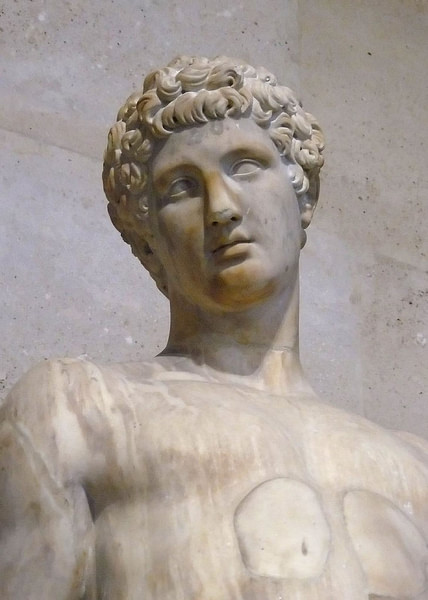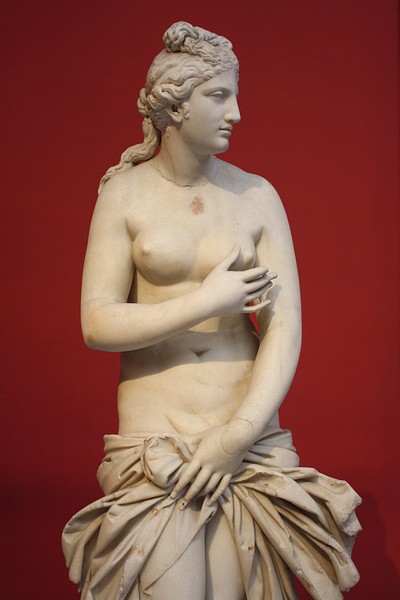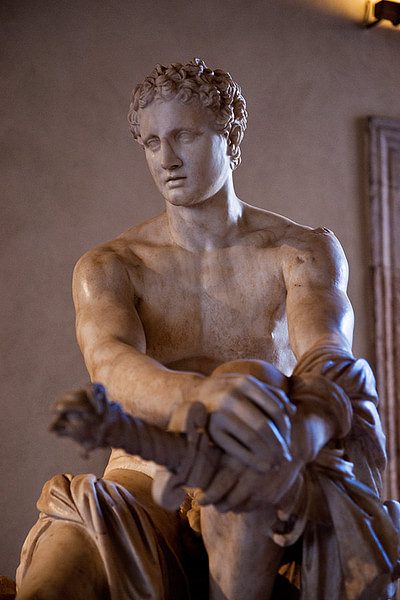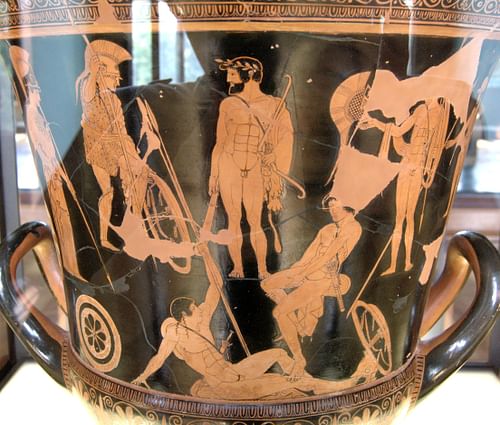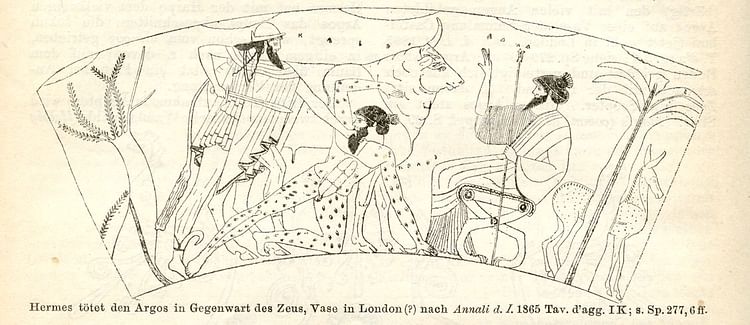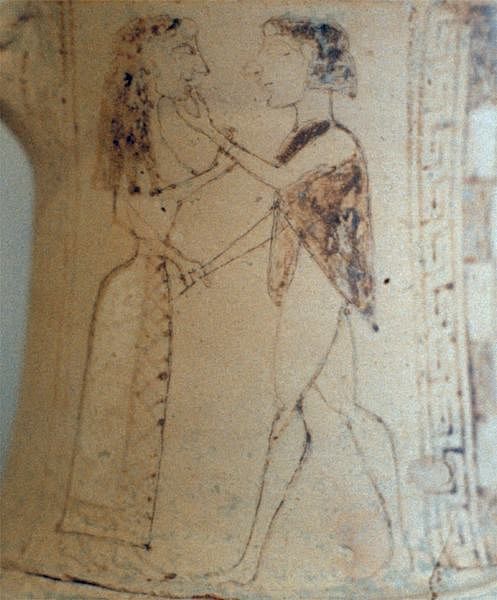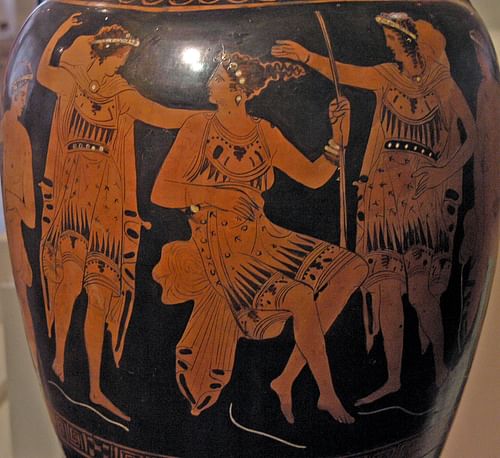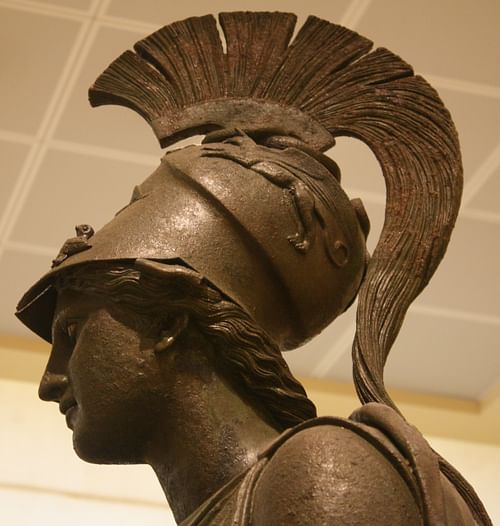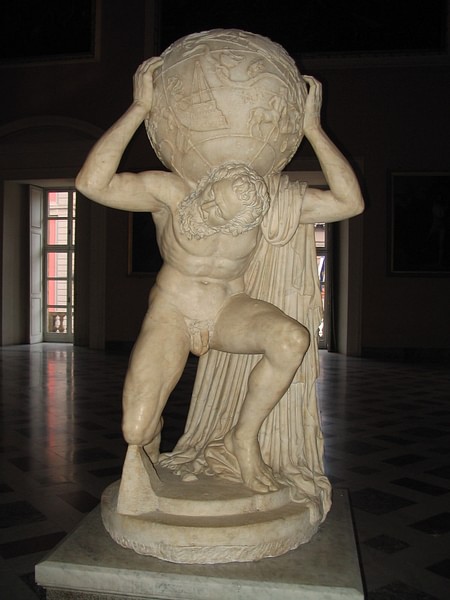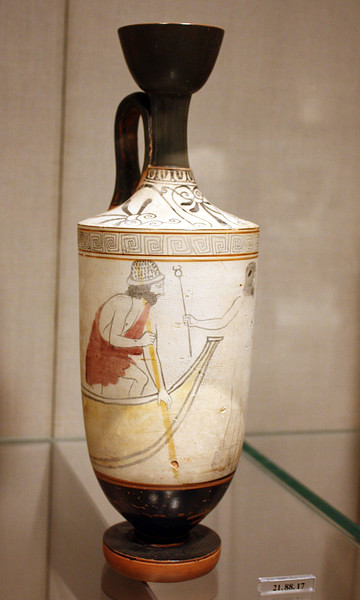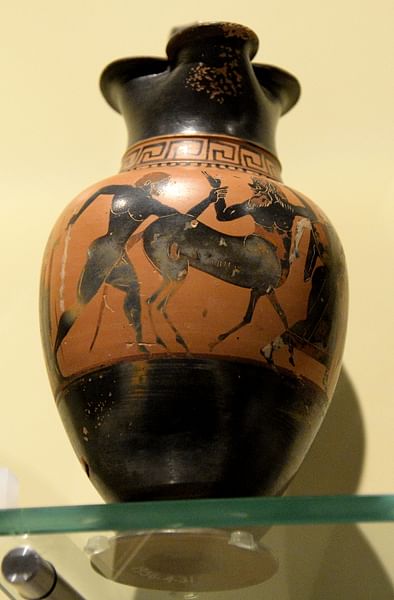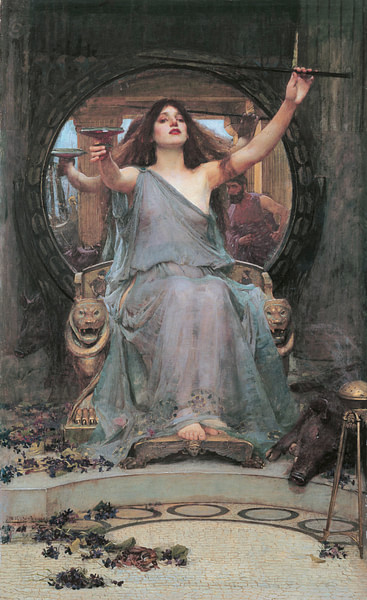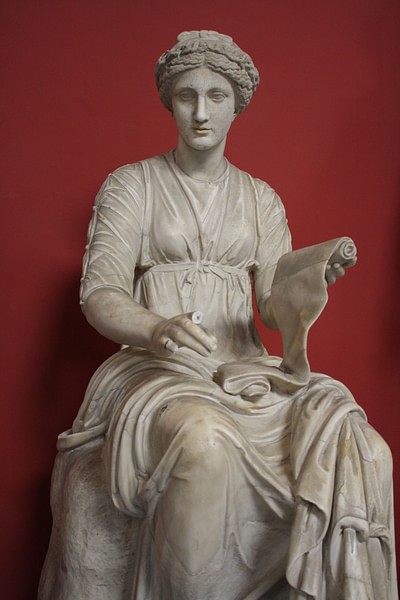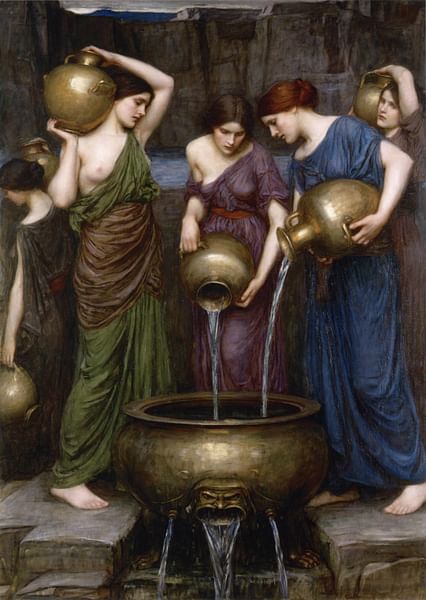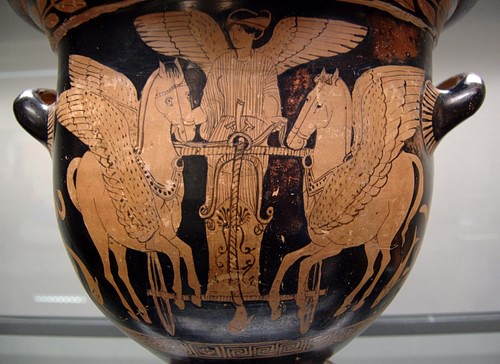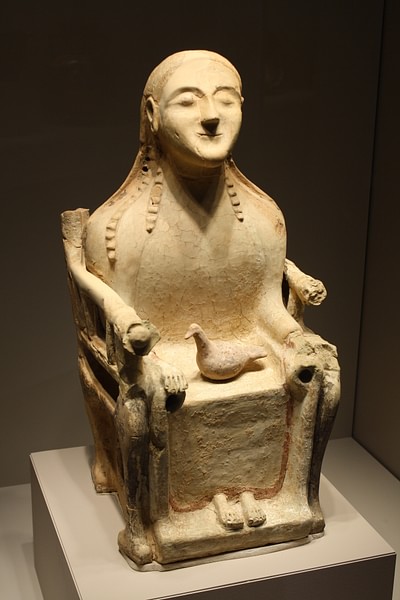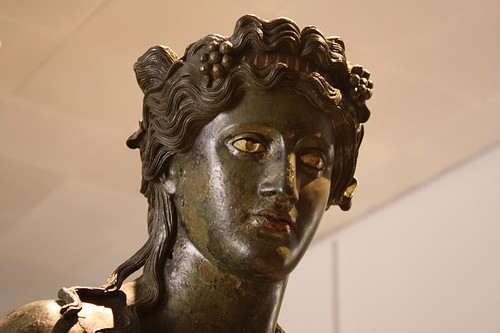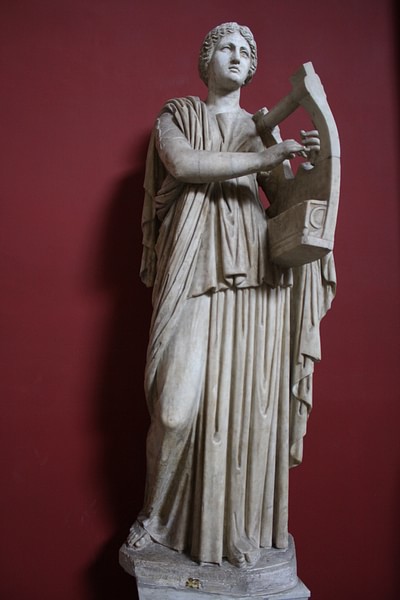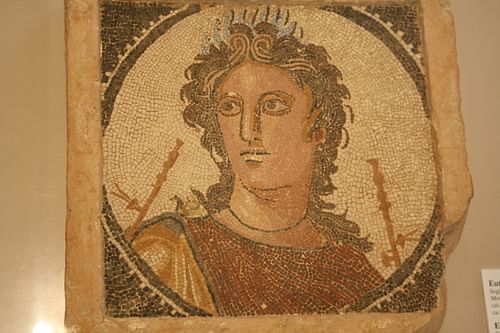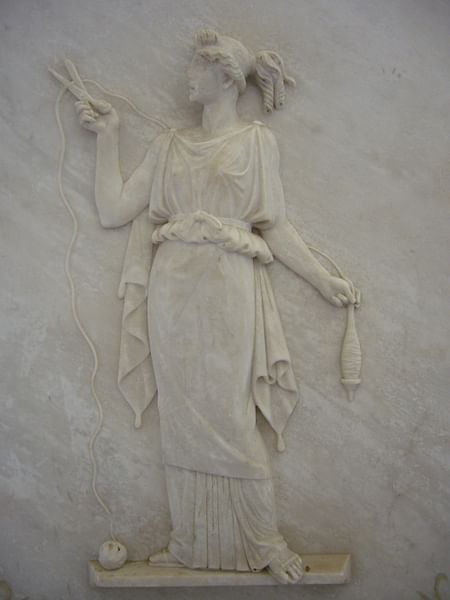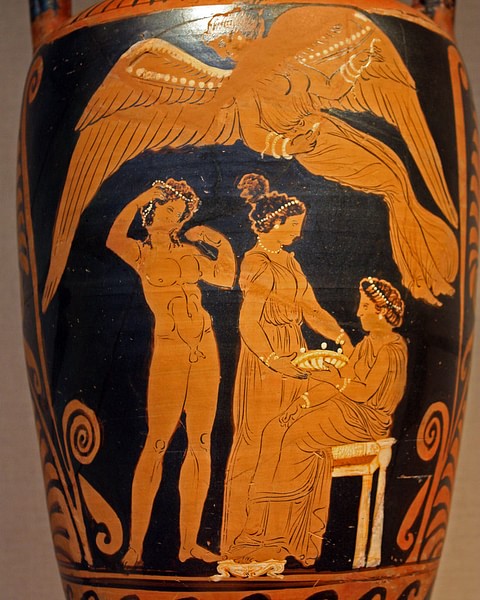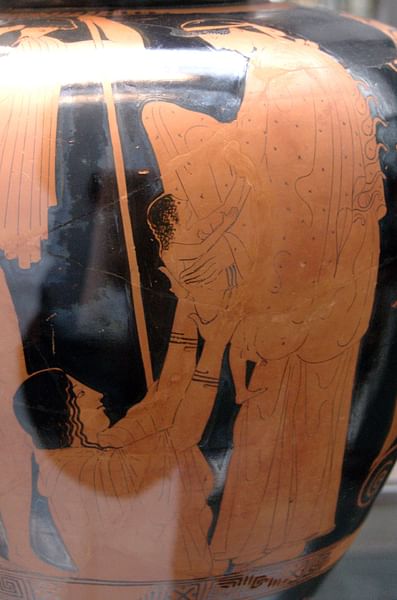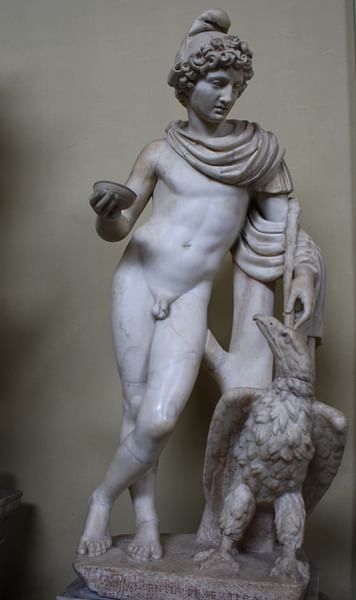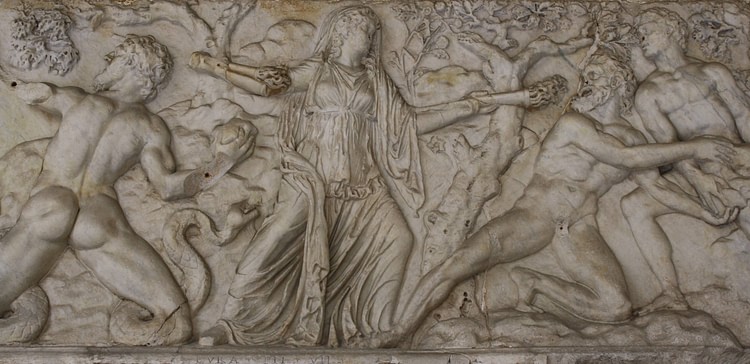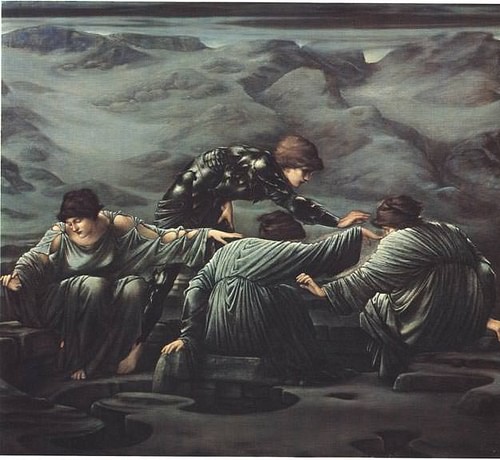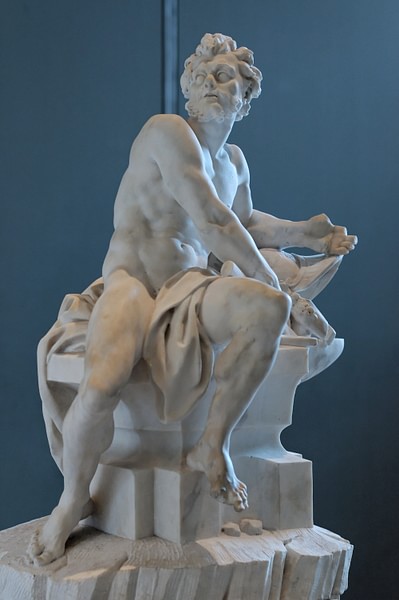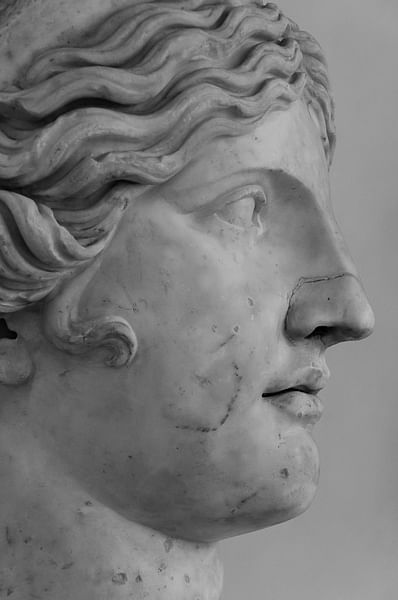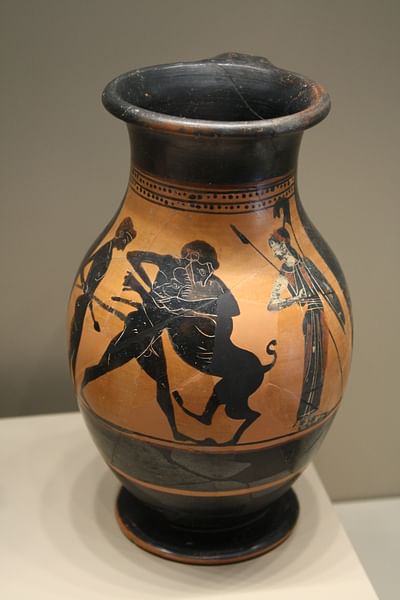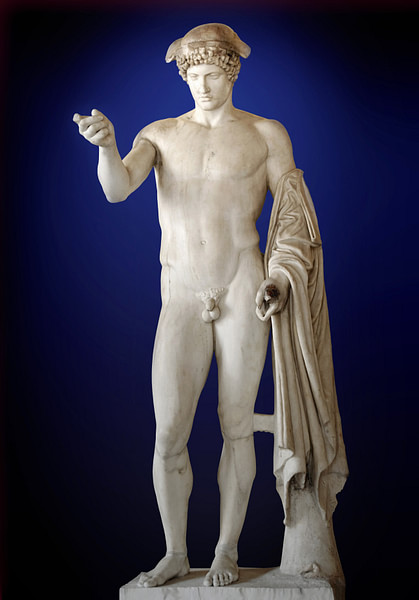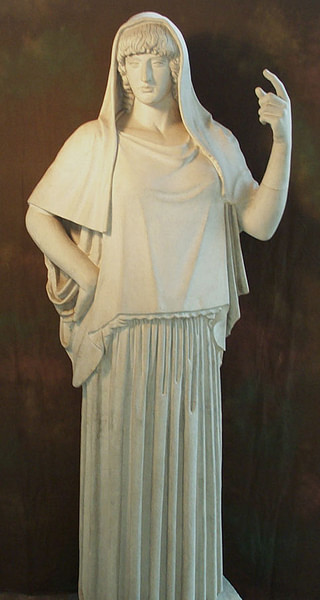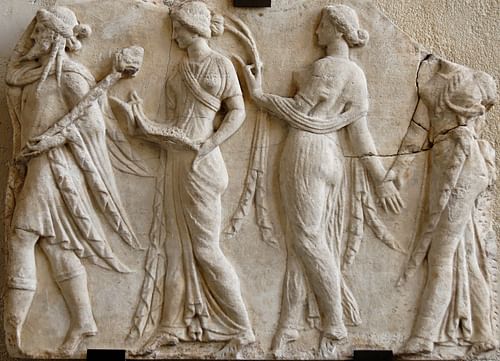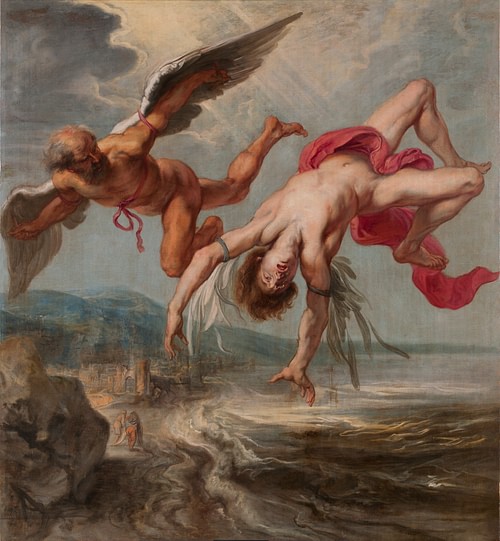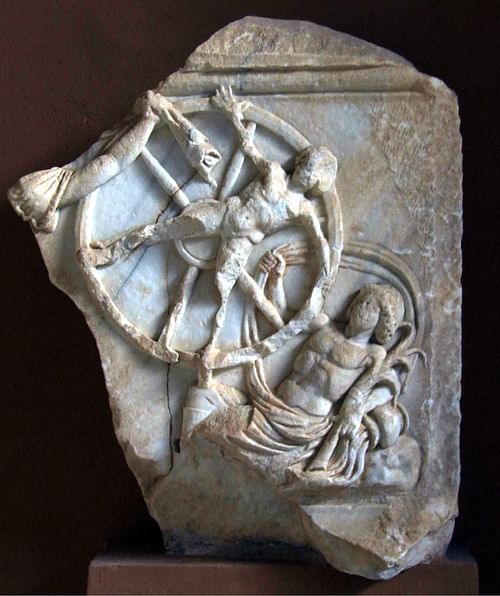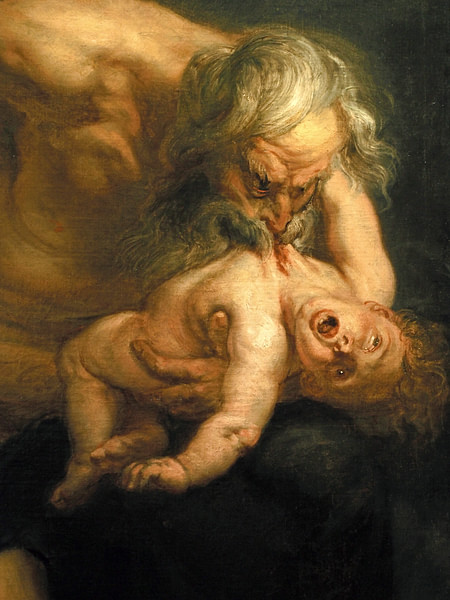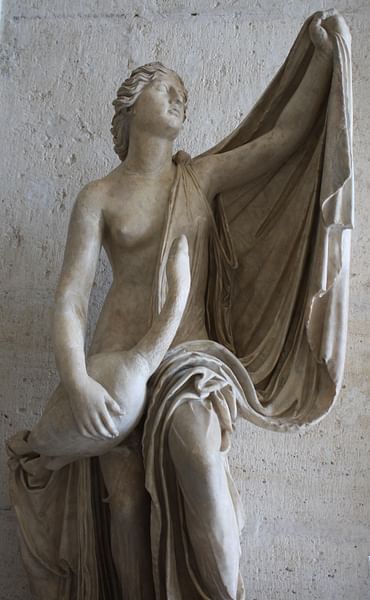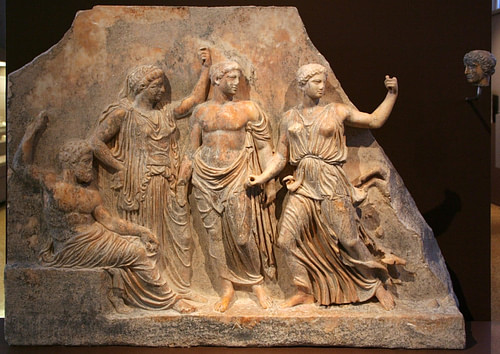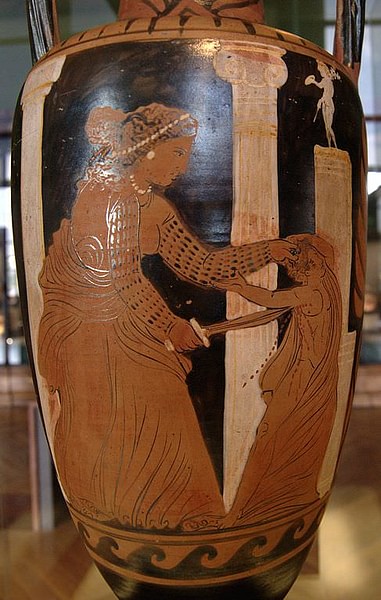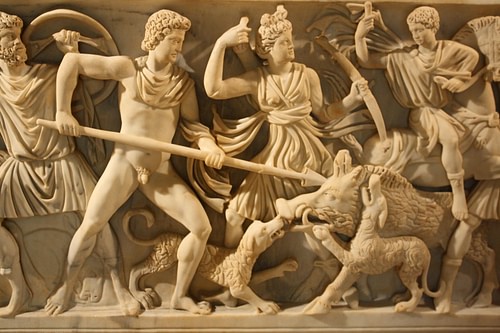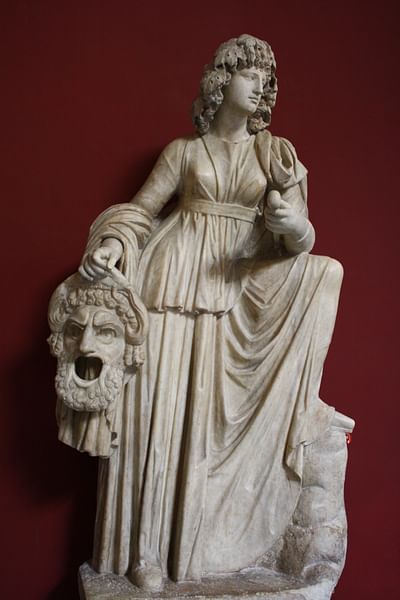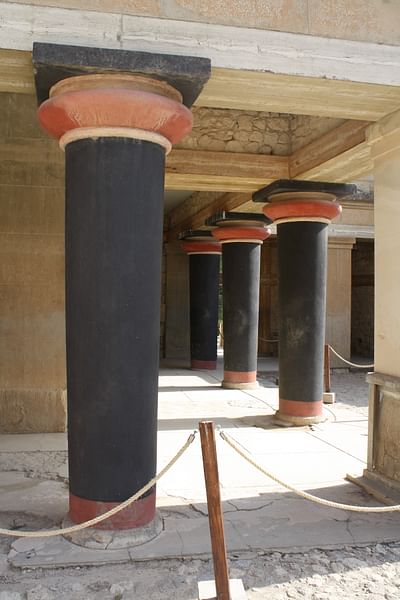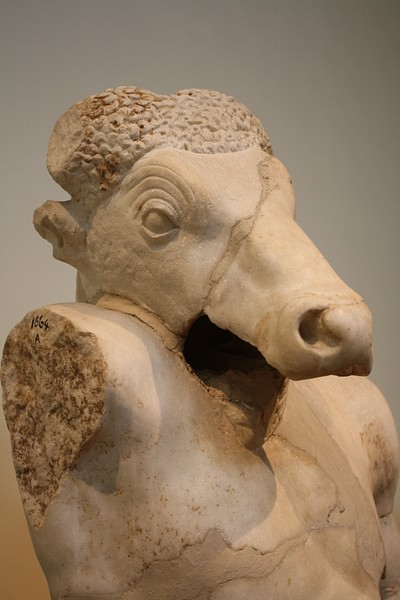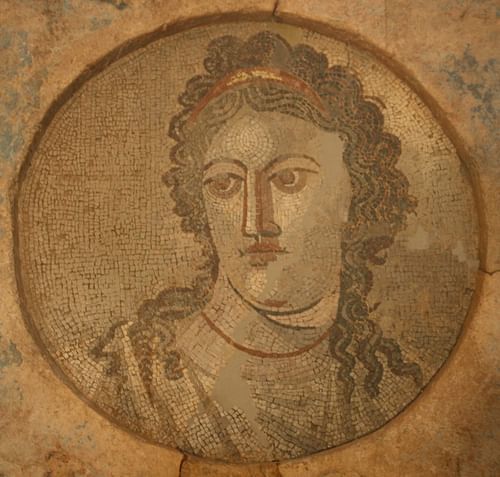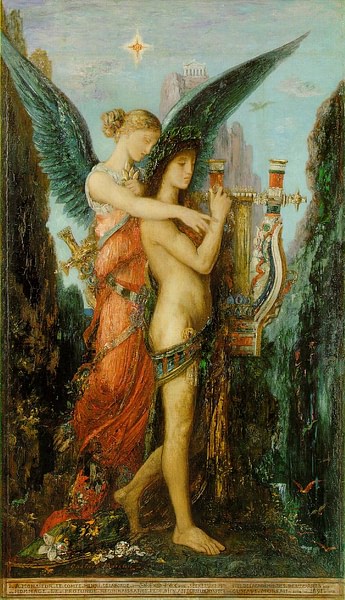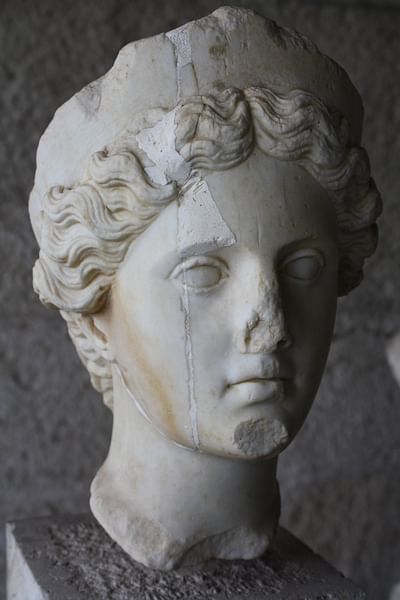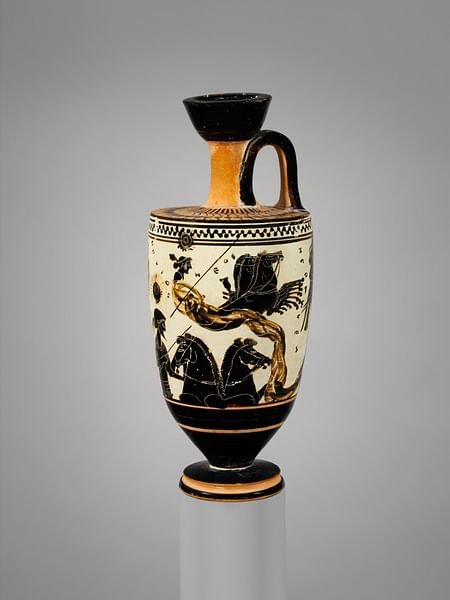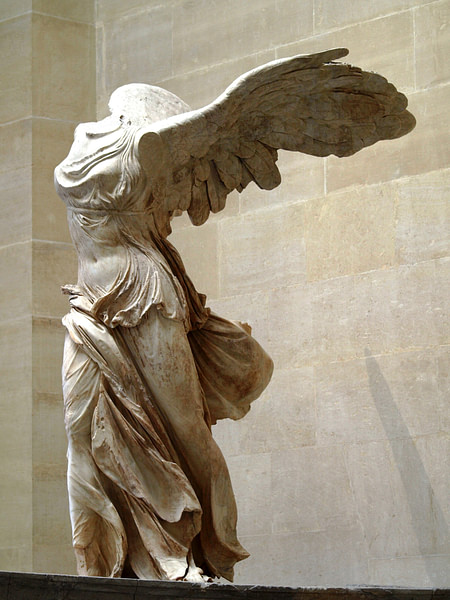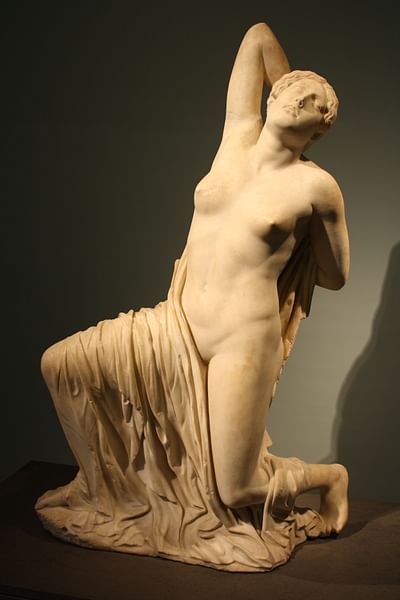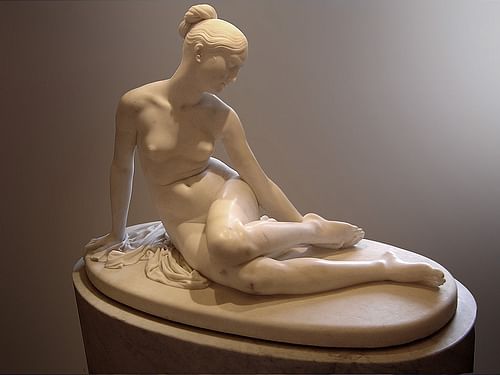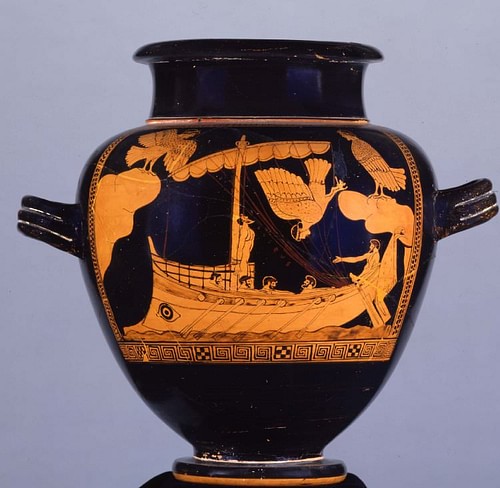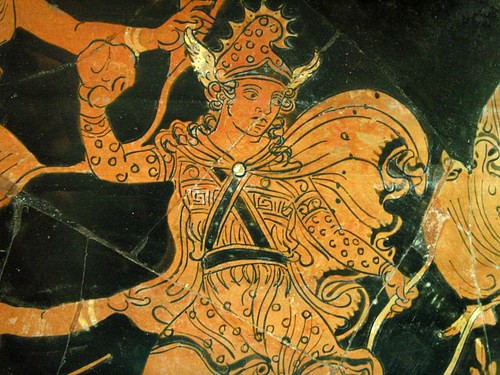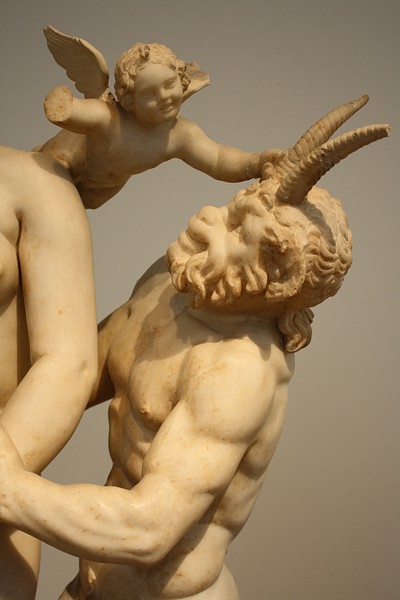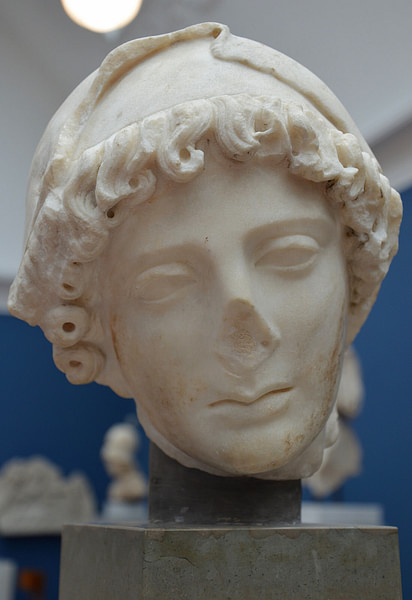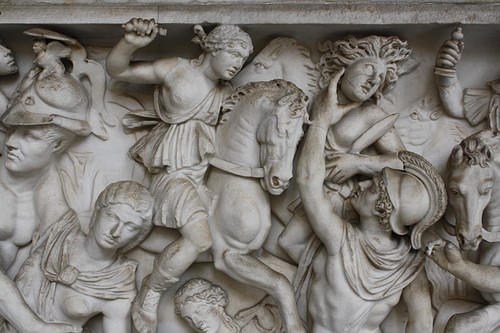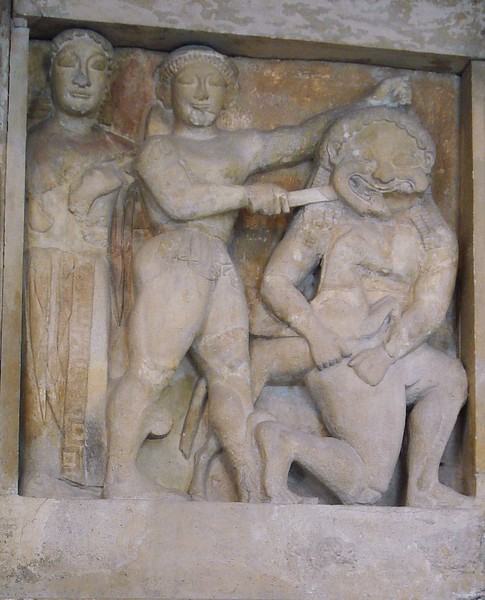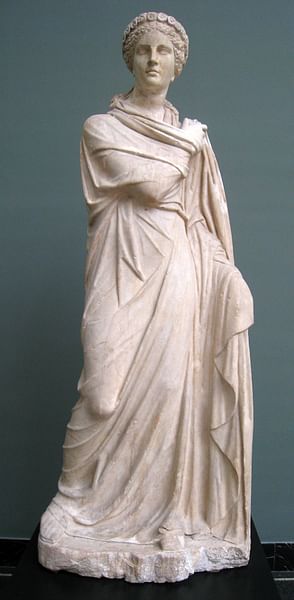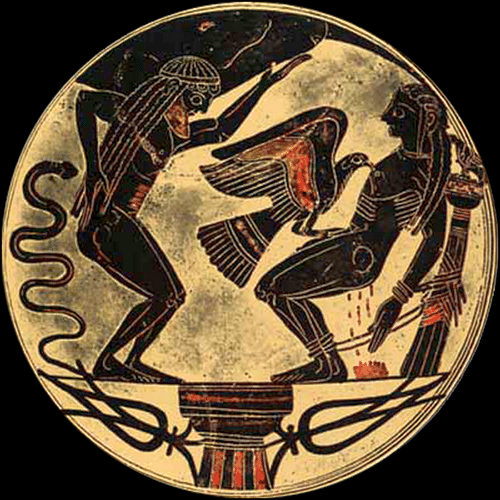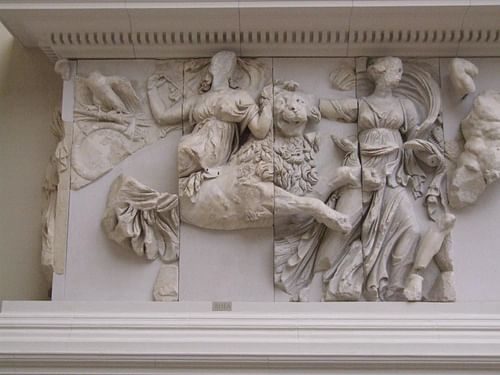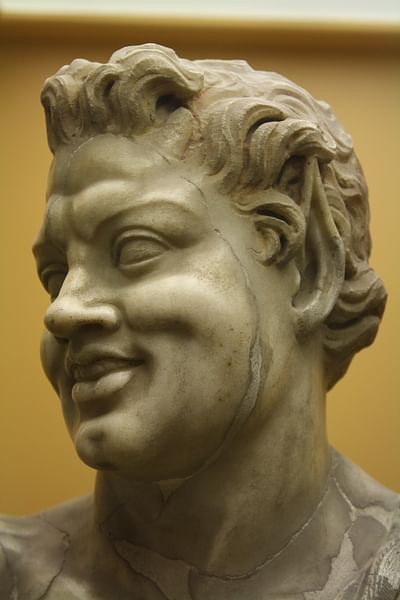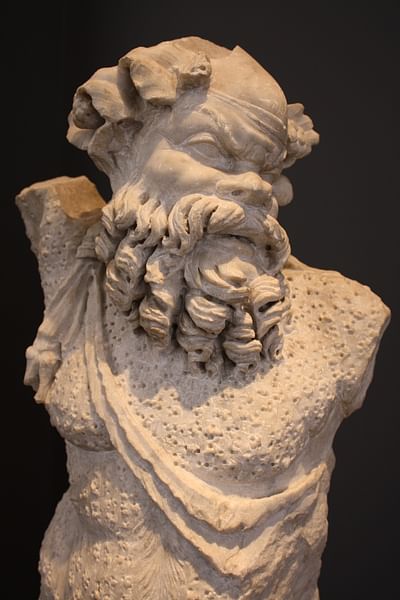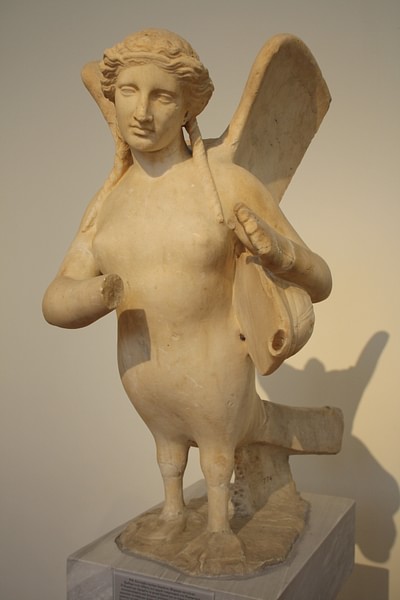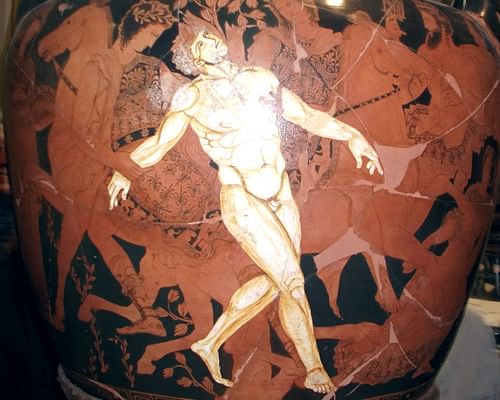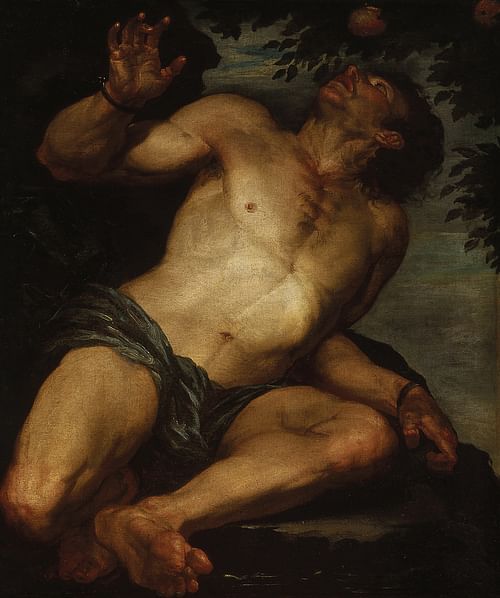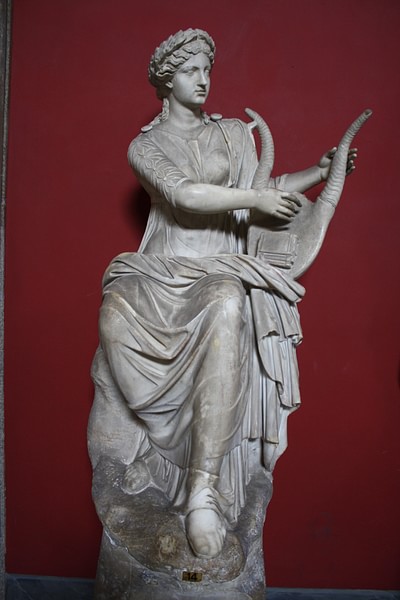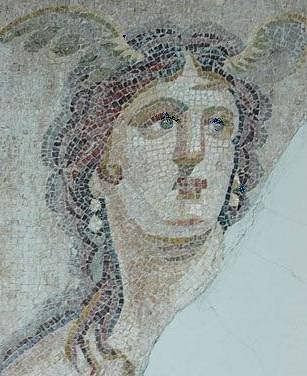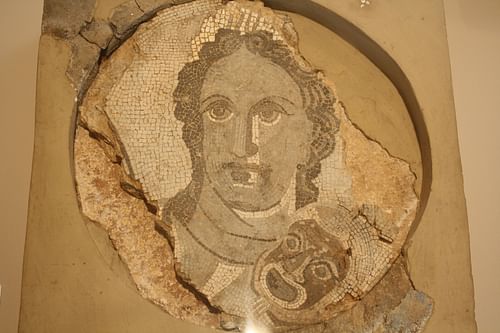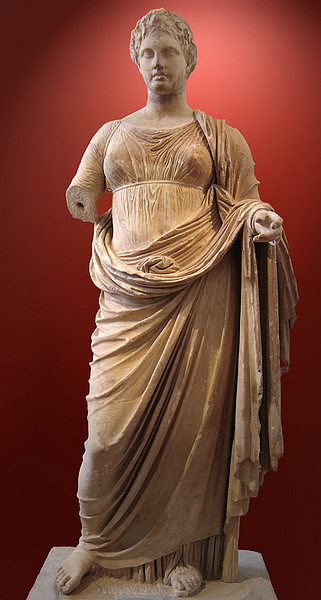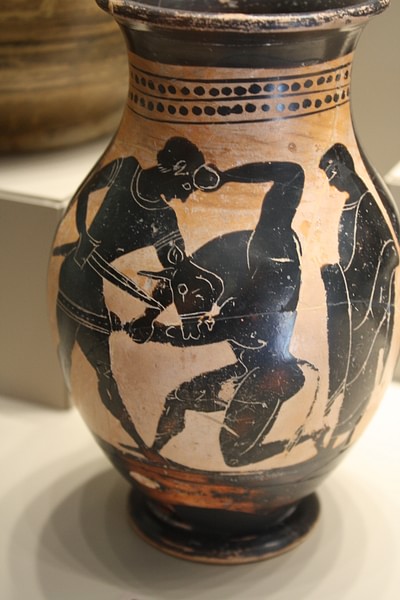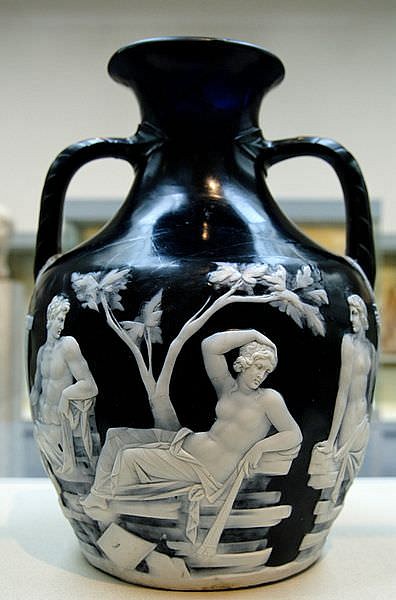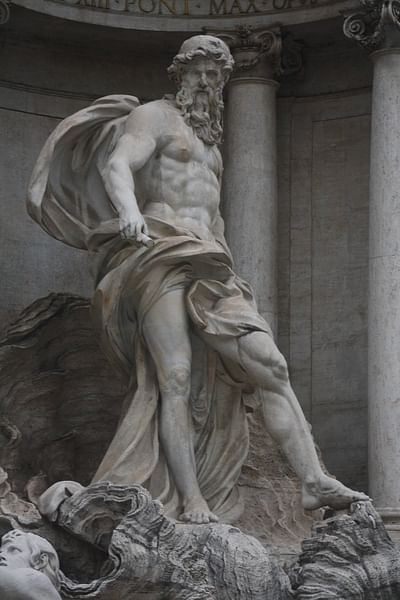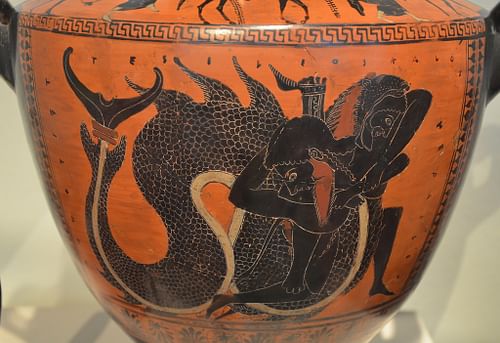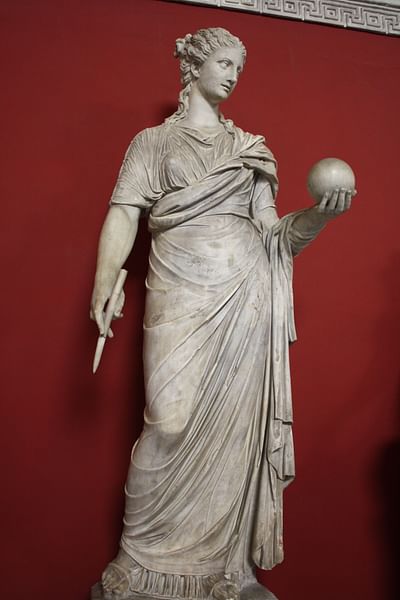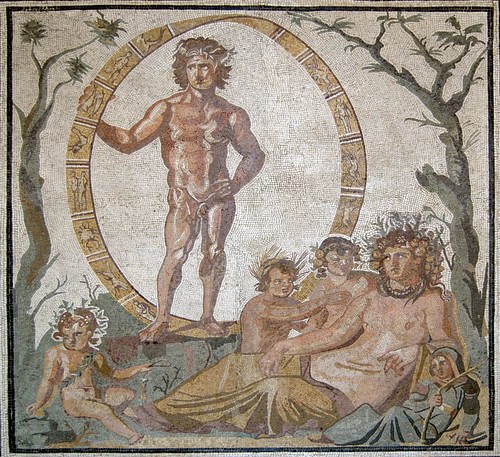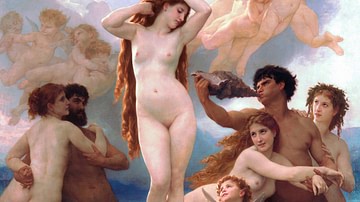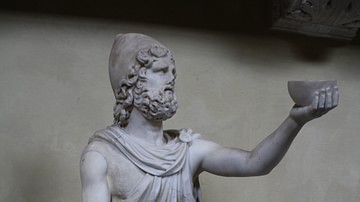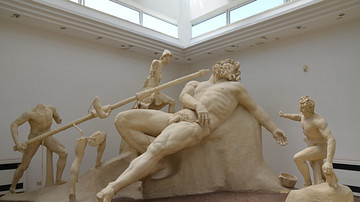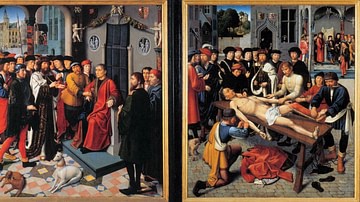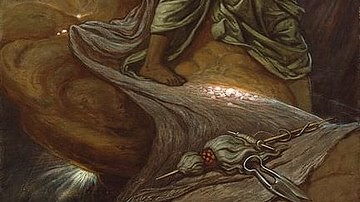Achilles
The hero of the Trojan War, leader of the Myrmidons, slayer of Hector and Greece's greatest warrior, who sadly came unstuck when Paris sent a flying arrow guided by Apollo, which caught him in his only weak spot, his heel.
Adonis
The impossibly handsome youth whom Aphrodite fell in love with. The goddess kept Adonis safe and sound in a chest guarded by Persephone, but she fell in love with him too and would not give him back. Zeus intervened and ruled Adonis should spend four months of the year with each lady. Tragically killed in a hunting accident he was transformed into a flower without scent. He may at once represent both the fertility and barrenness of the soil.
Agamemnon
King of Mycenae and leader of the Greeks during the Trojan War, his leadership skills were only equalled by his selfishness, the latter famously upsetting Achilles when he stole the hero's female war-booty Briseis. After 10 years of war, the king was killed by his jealous wife Clytemnestra and her lover Aegisthus while he was enjoying his coming-home banquet. The famous gold Mask of Agamemnon from Mycenae, in fact, predates him by four centuries.
Aphrodite
Goddess of love, beauty, and desire; her whisperings could derange both men and gods. She was especially worshipped on Cyprus, where she was believed to have risen from the foaming sea where Kronos threw the genitalia of his father Uranus. Unwilling wife of Hephaistos, she had famous flings with Ares, Hermes, and Dionysos.
Apollo
Dashing and handsome, the son of Zeus and Leto was the god of healing and the arts. Twin brother of Artemis, his famous offspring include Orpheus and Asclepius. Often represented holding a lyre, he was immensely popular and had many temples and sanctuaries dedicated to him, notably at Delos and Delphi where his oracle dwelt.
Arachne
The talented Lydian weaver who foolishly challenged Athena to a sewing competition. Arachne does indeed produce a mesmerising cloth, but Athena loses her cool and destroys it. When the girl hangs herself as a consequence, the goddess transforms her into a spider so that she can go on weaving forever.
Ares
The unpopular and troublesome god of war with a quick temper and never-ending thirst for battle. Handsome and courageous, the son of Zeus and Hera was a bringer of doom but was especially popular in martial Sparta. His children were Phobos (Fear) and Deimos (Terror), who often accompanied him on the battlefield.
Argonauts
The group of heroes who sailed on the Argo with Jason in his quest for the Golden Fleece. The team included Hercules, Theseus, the Dioskouroi, Atalanta, Orpheus, and Meleager.
Argus (aka Argos Panoptes)
The one-hundred-eyed monster of dubious parentage. Set to guard Io by Hera, the creature did not see his demise coming at the hands of Hermes.
Ariadne
The daughter of King Minos of Crete who helped Theseus escape the Minotaur's labyrinth by giving the hero a ball of string so that he might find the entrance again. Not getting much reward for her efforts she was shortly after dumped on Naxos where Dionysos picked her up to become the god of wine's consort.
Artemis
Goddess of hunting, fertility, wild animals, and childbirth, she was the daughter of Zeus and Leto, and twin sister of Apollo. Famously preferring a life of hunting to marriage, she had one of the Seven Wonders of the ancient world dedicated to her, the temple at Ephesos.
Asclepius
The god of medicine, he learnt his skills from his father Apollo and passed them on to such luminaries as Hippocrates. His medicinal skills were so effective that Zeus killed him with a thunderbolt for threatening the mortality of humanity. Asclepius' sanctuary at Epidaurus was famed throughout the ancient world and he is often depicted holding his staff (bakteria) with a sacred snake coiled around it.
Atalanta
The hero huntress who accompanied Meleager on the Calydonian boar hunt. Her other achievements included slaying a pair of centaurs and beating Peleus at wrestling. Long a maiden, she only consented to marry the man who could beat her in a foot-race. Hippomenes won her hand by dropping apples on the track to distract Atalanta, but the pair's matrimony was short lived for, after making love in a temple of Zeus, they were punished by the god who transformed them into lions.
Athena
The maiden goddess of wisdom, war, and crafts, she was Zeus' favourite daughter and patron of Athens, which dedicated the Parthenon to her. In art, she often wears armour and a helmet pushed back on her head as in the silver coins of Athens.
Atlas
The unlucky Titan who had to carry the heavens as a punishment from Zeus for leading the Titans against the Olympian gods in a failed attempt to control the universe. Father of many stars, including the Pleiades, he was Plato's king of Atlantis.

Bellerophon
The son of Poseidon who was famously tasked by King Iobates of Lycia with slaying the Chimera. This monster with a lion's body, a snake for a tail, and the head of a goat sprouting from its back was killed by the hero who flew his winged horse Pegasus.
Cadmus
The legendary founder of Thebes. Of Phoenician origin, he was sent to search for his sister Europa but, failing to find her, founded his city where a cow lay down, as instructed by the oracle of Delphi. He slew a dragon in the area and, sowing its teeth in the earth, he thus created the local population.
Calliope
The Muse of epic poetry and rhetoric. She is traditionally the most important of the nine Muses and is often depicted holding a writing tablet and stylus.
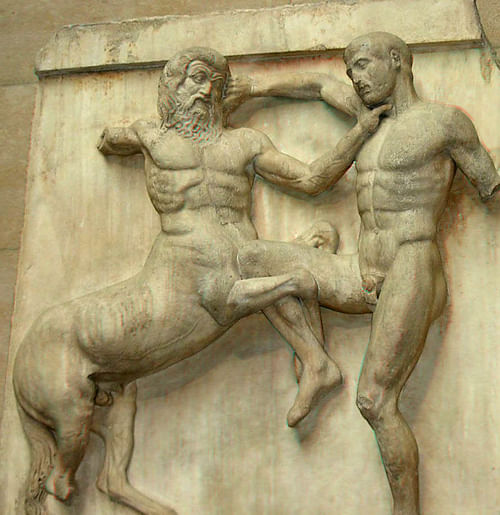
Centaur
The half-horse and half-man creatures who, often drunk, represented passions unabated and unbridled chaos. Living in Thessaly, some could be wise such as Chiron, tutor of Achilles, Hercules, and Asclepius. A popular subject in art, they appeared on several metopes of the Parthenon.
Cerberus
The ferocious three-headed hound of Hades which protected the entrance to the Underworld.
Charon
The ferryman who transports the souls of the dead across the river to Hades.
Charybdis
The sea monster which haunted the straits between Sicily and the Italian mainland, later rationalised as a whirlpool. Odysseus managed to escape it by grabbing onto an overhanging tree.
Chimera
The fire-breathing monster which is front-part lion with a snake's tail and the head of a goat on its back. Slain by the hero Bellerophon, it was the offspring of either Typhon and Echidna or reared by Amisodarus.
Chiron
The wise centaur who tutored Achilles, Jason, and Asclepius. He was especially knowledgeable of medicine and is often portrayed carrying a ready snack of hares over one shoulder.
Circe
The sorceress daughter of Helios and Perse who changed Odysseus' men into pigs. Although the hero himself could resist Circe's charms and magic by using the 'moly' plant, the group stayed on her island for a whole year, eventually acquiring useful advice for the perils of the journey home.
Clio
The Muse of history and often depicted holding a scroll.
Cyclopes
The one-eyed giants who live a savage, pastoral existence in a far off and unknown land. Hesiod describes three: Brontes, Steropes, and Arges, who are divine craftsmen, assistants to Hephaistos. Large Mycenaean fortification walls were credited to them, such was the size of the blocks used. Homer's Odysseus famously visited them and was captured by one, Polyphemus (see below).
Daedalus
He was the master craftsman who designed the Minotaur's labyrinth at Knossos, the wooden cow for Minos' wife Pasiphae to attract the bull she had fallen head over heels for, and various automatons. He was also the father of the hapless Icarus.
Danaids
The 50 daughters of Danaus who, avoiding marriage with the 50 sons of Aegyptus, fled with their father to Argos. The girls were pursued, though, and, on their wedding night, Danaus instructed them to kill the 50 men. One girl did not, Hypermestra, and she founded the dynasty of Argos. As a punishment for the dreadful deed (at least in Roman mythology) the girls must fill a large bowl with water down in Hades, made a neverending task as it has holes in it.
Dawn (aka Eos)
The winged daughter of Hyperion and Theia who rides a two-horse chariot across the sky each morning. Partial to handsome chaps she bagged the hunters Cephalus or Orion and the Trojan prince Tithonus, depending on the version of the myth. She asked Zeus to give the latter lover immortality but omitted to request eternal youth so that the poor fellow eventually withered away and was locked in a room as a mere keepsake. She was the mother of Memnon.
Demeter
Daughter of Kronos and Rhea, she was the goddess of fertility and agriculture. She managed to negotiate the release of her daughter Persephone from Hades and both were the focus of the Eleusinian Mysteries cult. In art, she often carries a torch, sceptre, or stalk of grain.
Dionysos
The bad boy of Mt. Olympus, he was the god of wine, merriment, and theatre. The son of Zeus and Semele could subvert the best intentions of gods and men with his wine and is often portrayed alongside his rowdy entourage of satyrs, nymphs, and maenads.
Echidna
The half-snake, half-woman monster who was the daughter of Phorcys and Ceto. With Typhon, she created more monsters, many of which Hercules and other heroes fought, including Cerberus, the Chimera, and the Lernaean Hydra.
Erato
The Muse of singing.
Eros
The forever youthful primaeval god of passionate desire, who brings irrepressible feelings and wild impulses to whoever his loosely aimed arrows hit. Assistant to Aphrodite, he was the protector of homosexual love.
Europa
The daughter of Phoenician king Agenor or Phoenix, who was abducted by Zeus who transformed himself into a bull. Arriving on Crete, the couple had three children: Minos, Rhadamanthys, and Sarpedon. Zeus gave her a hound who always got its quarry, Talos the bronze man, and a javelin which always hit its target. Europa later married the Cretan king Asterius.
Euterpe
The Muse of lyric poetry and often portrayed playing a double aulos or flute.
Fates (aka Moirai)
The three goddesses who personified Fate. They were Clotho, Lachesis and Atropos, and were daughters of Zeus and Themis.
Furies
Winged creatures, born from the blood of Uranus, who punish the wicked by dispensing disease and madness. Daughters of Earth and Sky, they also protected senior family members.
Gaia
The primaeval earth goddess. With Tartarus, she gave birth to the monster Typhon. In art, a popular depiction is Gaia giving the baby Ericthonius (an Athenian hero) to Athena.
Ganymede
The handsome Trojan prince who caught Zeus' eye and was transported by the god (or his eagle) to Olympus where he serves as a cup-bearer.
Giants
Born from Ge and the blood of Gaia or Uranus, these unruly and immensely strong creatures fought the Olympian gods but were defeated when the latter had help from Hercules. This battle, the Gigantomachy, was a popular subject in Greek temple sculpture. Their number included Pallas, Alcyoneus, Porphyrion, Polybotes, Ephialtes, Hippolytus, Enceladus and Eurytus. They were all either killed or imprisoned beneath the volcanoes of Greece and Italy.
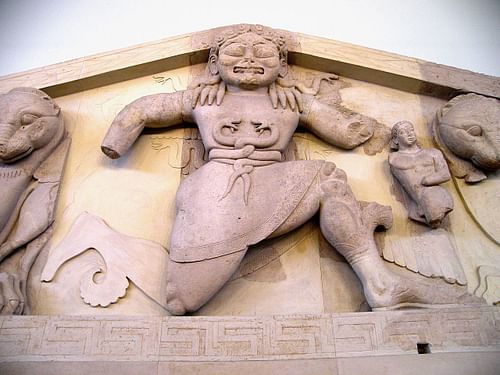
Gorgons
The three monstrous sisters - Medusa, Stheno and Euryale - whose stare could turn onlookers into stone. In Archaic art, they have sharp teeth and flowing locks of snakes, but in later times they are portrayed as beautiful women. They frequently appear on temple pediments, shields, and armour.
Graeae
The three sisters who share one tooth and one eye between them. The hero Perseus consulted them on the whereabouts of Medusa and got his answer by stealing their eye. They were the daughters of Phorcys and Ceto, and are named as Pemphredo, Enyo and Deino.
Graces
Three (or more) goddesses who personified charm, grace, and beauty in all its forms from the aesthetic to the intellectual. Offspring of Zeus and Eurynome, they were also accomplished at poetry, dancing, and music, and particularly associated with spring flowers.
Hades
The name of the Underworld and the god who ruled it. Brother of Zeus and Poseidon, Hades abducted Persephone, tricking her with a pomegranate, but was compelled to give her up for half the year. He may be represented holding a cornucopia - symbol of the life which comes from the soil - a staff, or riding a chariot pulled by black horses. Hades the place was not necessarily a place of suffering but conceived as the last resting place of the soul. However, very wicked people were taken by the Furies down to the lowest level - Tartarus - and there received eternal torments.
Hecate
The moon goddess associated with witchcraft, magic, doorways, and creatures of the night - especially hounds and ghosts. Hesiod makes her daughter of Perses and Asteria. She is often depicted with three faces representing her role as guardian of crossroads.
Hector
The wise and noble son of the Trojan king Priam; he is the great hero of the city but falls at the hands of Achilles during the Trojan War. In vengeance for his killing of Patroclus, his body is dragged around the city walls behind the chariot of his slayer. Priam successfully appeals to Achilles for the restoration of his son's body whose funeral closes the Iliad.
Helios
The god of the sun who rode his golden chariot across the skies each day. Son of the titans Hyperion and Theia, he was famously represented by the Colossus of Rhodes, one of the Seven Wonders of the ancient world.
Hephaistos
The genius blacksmith and god of fire, metallurgy, and crafts, he was lame after he was thrown from Mt. Olympus by either Zeus or his mother Hera, upset at his ugliness. Husband of Aphrodite under false pretences, from his workshop on Mt. Etna he created such wonders as the aegis of Zeus, the helmet of Hermes, the first woman Pandora, and the great shield of Achilles.
Hera
The famously jealous wife of Zeus, often with good reason, she was the goddess of marriage and family. Representing the ideal woman and fidelity, the daughter of Kronos and Rhea would take awful revenge on many of her husband's lovers and resulting offspring, especially Hercules. Patron of Argos, she was the mother of Ares, Hephaistos, and Hebe, amongst others.
Hercules
The semi-divine hero and son of Zeus and Alkmene, who performed such prodigious deeds that he won immortality and his place amongst the Olympian gods. His 12 mighty labours included slaying monsters like the Lernaean Hydra, the Stymphalian Birds, and the ferocious three-headed hound of Hades, Cerberus. He is usually portrayed in art carrying a huge club and wearing the skin he ripped from the Nemean Lion, another of his victims.
Hermes
The herald and messenger of the gods was himself the god of trade, wealth, luck, language, thieves, and travel. Son of Zeus and Maia (daughter of Atlas), he was an impish seeker of amusement but had a more serious role as leader of dead souls to the River Styx. Patron of the home, he is often depicted wearing winged sandals or hat and holding his herald's staff or kerykeion.
Hestia
The virgin goddess of the hearth, home and hospitality who is the daughter of Kronos and Rhea.
Horae (aka Hours)
The daughters of Zeus and Themis, who personified the seasons. They are Eunomia (Good Order), Dike (Justice) and Eirene (Peace) with their mother as the fourth and representing Divine Law. The three sisters guard the gates of Mt. Olympus.
Hypnos
The son of Nyx (Night) and personification of Sleep, he lives in the Underworld. Often depicted as a winged youth, he touches the head of the tired with a branch or pours a magic liquid on them to induce slumber.
Icarus
The son of the master craftsman Daedalus, who flew too close to the sun and so the wax melted on his artificial wings fashioned by his father in order to escape King Minos of Crete. Falling into the sea and drowning, the stretch of waters in that area became known as the Icarian Sea, and then, when Hercules dragged the washed up body to an island, he renamed that place Icaria in honour of the fallen youth.
Ixion
The king of the Lapiths in Thessaly who, in order to avoid paying the handsome bridal gifts for his future wife Dia, prepared a trap for her father Eioneus. This was a concealed pit, at the bottom of which was a charcoal fire. Invited for absolution at Mt. Olympus following the murder of Eioneus, Ixion then attacked Hera. Zeus had fooled him, though, into thinking a cloud was actually Hera and then punished Ixion by having him tied to an ever-spinning wheel of fire in Hades.
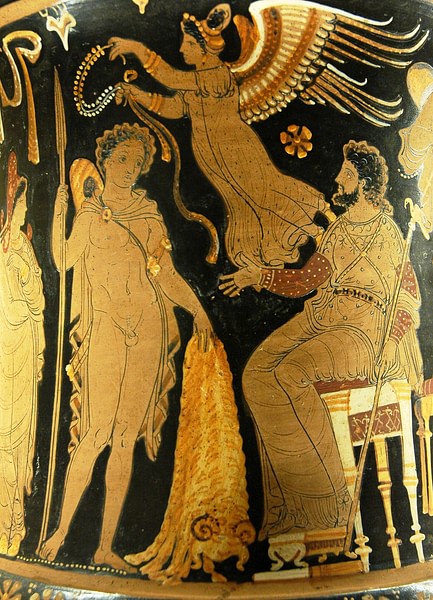
Jason
The hero whose father Aison had been robbed of his kingdom by Pelias, and when Jason came to claim his rightful inheritance, Pelias sent him on the impossible task of finding the Golden Fleece. Happy to oblige, Jason assembled his crew - the Argonauts of the ship Argo - and, with help from Athena, brought back the Fleece to Thessaly along with his sweetheart Medea. Pelias refused to give up the throne, Medea killed him with a potion, and the couple settled, in any case, in Corinth.
Kronos (aka Cronus)
The Titan who was the son of Uranus and Gaia. He killed and castrated his father and then married his sister Rhea to produce the Olympian gods. Afraid he would be overthrown like his father, Kronos devoured all of his children, but Rhea saved Zeus, whom she hid on Crete, giving her husband a rock as a substitute. Gaia contrived for Kronos to cough up his children, who, led by Zeus, promptly did overthrow him. Kronos was then imprisoned in Tartarus. In other versions, he is king of a Golden Age and rules a land of paradise.
Leda
Leda was the queen of Sparta and mother of Clytemnestra. She was seduced by Zeus who took the form of a swan, and from this union was born Helen (from an egg) and the twins Castor and Pollux, the Dioscuri. In some versions, it is Nemesis who is seduced and Leda only looks after the egg and resulting offspring.
Leto
Daughter of the Titans Coeus and Phoebe, she is the mother (with Zeus) of Apollo and Artemis, giving birth to her offspring on the island of Delos, hence its important sanctuary to Apollo.
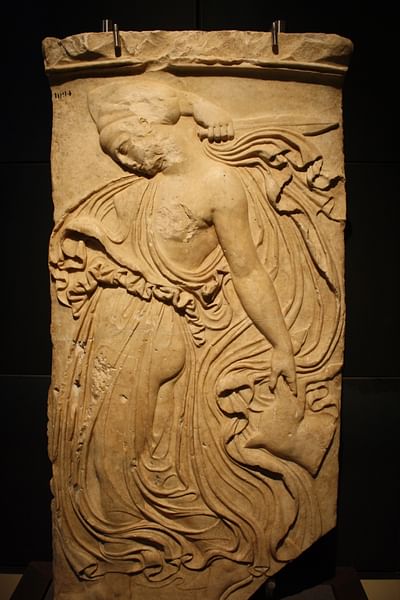
Maenads
The female followers of Dionysos who participated in frenzied rituals of dancing and music.
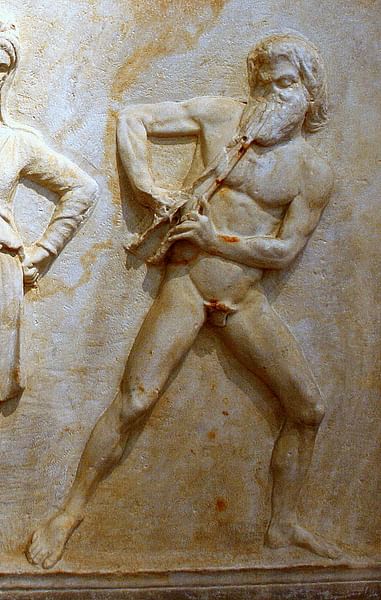
Marsyas
The satyr who was gifted at playing the aulos but, after foolishly challenging Apollo to a musical competition, lost and was flayed alive for his troubles.
Medea
The daughter of Aeetes, king of Colchis and granddaughter of Helios, she was skilled in the arts of magic and potions. She helped Jason steal the Golden Fleece by charming the dragon which protected it. She then hampered the pursuit of the Argonauts by dismembering her young brother Apsyrtus. In another shocking episode, she tricked Pelias' daughters into chopping him up and boiling him in a big pot as a punishment from Hera. Medea fled to Corinth with Jason, but rebuffed by the hero, she killed his new love Glauke and then her own children in spite. Fleeing again, this time in a dragon-pulled chariot to Athens, she would later try to poison Theseus, thus fully completing her reputation as an all-round bad egg.

Medusa
The gorgon whose stare turned onlookers to stone. She had once been very beautiful but was transformed into a hideous gorgon by Athena after she had been raped by Poseidon in one of the goddess' temples. Killed by the hero Perseus, from the blood of her decapitated torso sprang Chrysaor and the winged horse Pegasus.
Meleager
He was a hero who successfully led an all-star expedition to hunt and kill the Calydonian boar which had been terrorising central Greece. Known as an all-round good egg, he had also been one of the argonauts with Jason who found the Golden Fleece.
Melpomene
The Muse of tragedy plays, hence usually portrayed holding a tragedy theatre mask.
Menelaos
The younger brother of Agamemnon, and the king of Sparta whose wife Helen ran off with Paris sparking the Trojan War. He survived the conflict and eventually returned home via Egypt.
Metis
The first wife of Zeus and personification of Intelligence. Zeus swallowed her as he feared she was pregnant with a child who would overthrow him. From this action sprang Athena, born from the god's head.

Midas
The king of Phrygia who had the knack of changing anything he touched into gold, a skill he received from Dionysos in thanks for looking after the satyr Silenus. A less favourable trait were his donkey ears, given to him by Apollo after Midas had judged Pan the better musician of the two.
Minos
The king of Crete whose palace at Knossos contained the labyrinth and Minotaur. The terrible half-man, half-bull creature was the fruit of Minos' wife Pasiphae's amorous engagement with a bull sent by Poseidon to punish the king for not sacrificing a prize bull to the god as promised. Minos extracted yearly tribute from Athens in the form of young men and women who were sacrificed to the Minotaur, but the hero Theseus managed to slay the Minotaur and end the practice. Minos was the son of Zeus and Europa but was mortal as his sticky end reveals. Falling out with Daedalus, the architect of his labyrinth, the king pursued him to Camicus but was boiled in his bath by the king's daughters there. In the afterlife, he was made a judge of souls along with his brother Rhadamanthys.
Minotaur
The half-man, half-bull creature which was the fruit of Minos' wife Pasiphae's amorous involvement with a bull sent by Poseidon. Haunting the labyrinth of Knossos, he would be killed by the Athenian hero Theseus, keen to put an end to the yearly sacrificial offerings of young men and women.
Mnemosyne
The Titan who was the personification of Memory and mother of the nine Muses.
Muses
Nine masters of the arts. Daughters of Zeus and Memory (Mnemosyne), they gave the arts to mankind so that they might forget their troubles and to inspire artists of all kinds. They were: Calliope, Clio, Erato, Euterpe, Melpomene, Polymnia, Terpsichore, Thalia, and Urania.
Narcissus
The young hunter from Thespiae in Boeotia, he was the son of Cephissus and the nymph Liriope. The impossibly handsome youth one day fell in love with his own reflection in a pool of water in the forest. Pining away from thirst and despair, and ignoring the attentions of Echo, he died but was transformed into a flower of the same name. Narcissus was especially popular in Roman art and appears in over 50 wall paintings at Pompeii.
Nemesis
Both a goddess and the personification of retribution. Daughter of Oceanus and Night, she is relentless and merciless, especially punishing hubris.
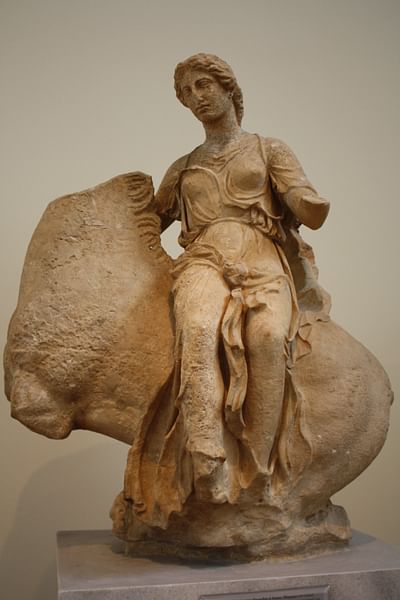
Nereid
The sea nymphs who are the daughters of Nereus. They can assist sailors and are often in the company of Poseidon.
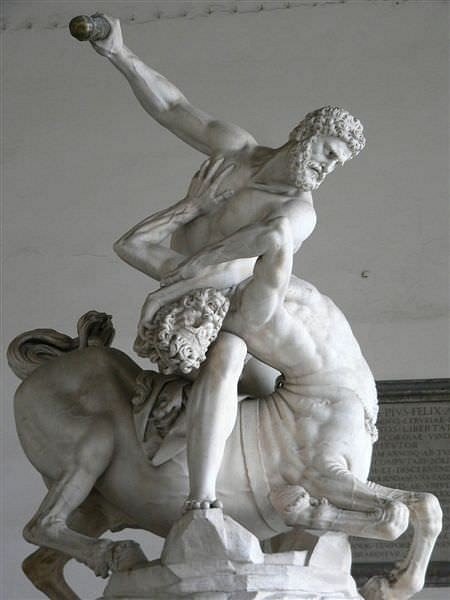
Nessus
The centaur who unwisely picked a fight with Hercules and was struck by the hero's arrow for his troubles. In his revenge, though, Nessus tricked Hercules' wife Deianeira into using his blood which acted as a poison and killed his slayer when Deianeira coated her husband's cloak with it.
Night (aka Nyx)
Born from Chaos she personifies Night and is feared by both gods and men. Connected to oracles, she is also the mother of Sleep (Hypnos).
Nike
The winged personification of Victory, whose father was the Titan Pallas and mother Styx. She was a popular subject in art, often accompanying Athena and famously represented in the statue from Samothrace and on the hand of the giant statue of Zeus at Olympia, one of the Seven Wonders of the ancient world.
Niobe
The daughter of Tantalus and wife of Amphion of Thebes, she foolishly boasted that as she had so many children she was superior to Leto. The goddess promptly sent her children Apollo and Artemis to put Niobe in her place. Apollo killed all Niobe's sons with his bow, and Artemis did the same to the daughters. The distraught mother then became a rock on Mt. Sipylus which, washed continually with waters, mimicked Niobe's weeping forever.
Nymph
Young females who hang around natural features such as rivers, springs, mountains, caves, and particular trees. They are often found in the company of Artemis and Pan, and they can help hunters and sailors but may be prone to abduction where handsome youths are concerned. If rebuffed, they could turn violent, as in the case of Echenais who blinded the Sicilian herdsman Daphnis.
Oceanus
The Titan son of Uranus and Gaia. His waters encircle the world and so is the source of all rivers. His wife is Tethys with whom he fathered the Oceanids and river-gods.
Odysseus
The wily king of Ithaca known for his quick wits, courage, and leadership. The son of Laertes and Antikleia, he was instrumental in the Trojan War by persuading Achilles to join the cause and coming up with the ruse of the Trojan Horse. The voyage back home from Troy turned into an epic adventure and subject of Homer's Odyssey. He encountered the Sirens, the Cylcops Polyphemos, visited Hades, and spent an age with the lovely Calypso, but eventually made it back to his faithful wife Penelope and son Telemachus.
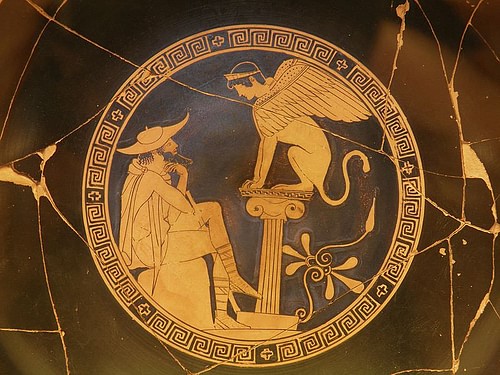
Oedipus
The king of Thebes who tragically confused his family relations, killing his father and, after solving the riddle of the sphinx, marrying his mother Epicaste (later Iocasta), both by mistake. Following his mother's suicide, and blinding himself for his stupidity, their descendants were cursed to endure many miseries. He is the subject of the famous tragedy named after him by Sophocles.
Olympus
The home of the Olympian gods and Greece's highest mountain at 2,918 m.
Orion
The mighty hunter who was the son of Poseidon and Euryale, one of the Gorgons. He famously had 50 sons with 50 different nymphs, tried to woo Artemis, and famously pursued the Pleiades, but was shot by the huntress goddess and transformed into a constellation for his troubles. The appearance, rise and fall of his stars was used as a guide for when to perform certain agricultural tasks by ancient farmers.
Orpheus
Son of Apollo and the Muse Calliope, no wonder Orpheus was a virtuoso musician and poet. His lyre-playing calmed the Sirens on Jason's Argonaut expedition for the Golden Fleece and charmed Persephone to release from Hades his dead love Eurydice. He won his case but broke his promise not to look back on leaving the underworld and so his love was taken from him forever. Distraught, the great artist never played again, and he met a sticky end, ripped apart by the Maenads for being miserable.
Pan
The pastoral god who dwelt amongst the mountains, caves, and rivers of Greece. With the legs and horns of a goat, the patron of shepherds was the inventor and master of the syrinx or panpipes, which had been the nymph of the same name, but she panicked at Pan's attention and transformed herself into reeds, which the god then blew to create musical sounds.

Pandora
The first woman, made by Hephaistos (or in other versions Prometheus) and beautified by the impressive team of Athena, Hermes, Aphrodite, and the Graces; she opened the jar she was expressly told not to and so let out all the ills of the world leaving inside, caught on the lip, only one consolation: hope.
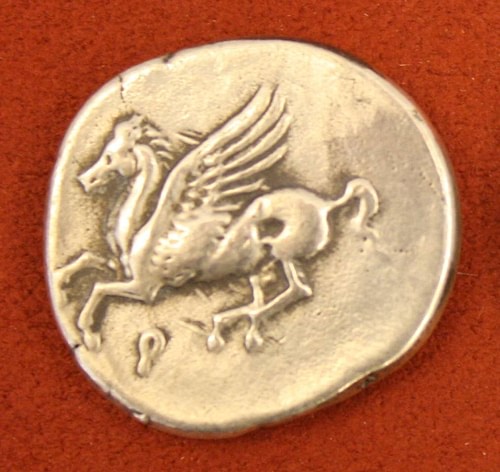
Pegasus
The winged horse of Bellerophon, which was born from Zeus and the blood of Medusa. Pegasus helped the hero slay the Chimera and then enjoyed a semi-retirement on Mt. Olympus, where he brings Zeus' thunderbolt whenever required. The horse was a popular design on coins, especially those of Corinth.
Penelope
The faithful wife of Odysseus, who warded off many suitors while her husband was fighting during the Trojan War and then dallying on his long odyssey home. One of her delaying tactics was to tell her suitors she first had to finish weaving a shroud for Odysseus' father Laertes, but each night she pulled out what she had woven that day. She is the mother of Telemachus.
Penthesilea
The amazon daughter of Otrere and Ares, who accidentally killed her colleague Hippolyte. She later led an army to assist Priam during the Trojan War but was killed by Achilles.
Persephone (aka Kore)
She was the goddess of vegetation, especially grain. Abducted by Hades to live with him in the Underworld, the beautiful goddess was eventually released, but by a trick of a pomegranate seed, she was compelled to return to Hades for a portion of the year. This was symbolic of the agricultural cycle or the common practice of burying seeds underground. Like her mother Demeter, she was an important focus of the Eleusinian Mysteries and Thesmophoria festival.
Perseus
Helped by Athena and given the invisible-making cap of Hades and a giant sword and winged sandals from Hermes, the hero made good on his rash promise to king Polydectes and beheaded Medusa. On his way home, he won the hand of fair Andromeda, the Ethiopian princess who was tied to a rock and left to Poseidon's dreadful sea-monster in punishment for her mother Cassiopeia's boast she was prettier than the Nereids, the sea-gods children. Using the head of Medusa, the hero turned the monster to stone and rescued Andromeda.
Pleiades
The seven daughters of Atlas and the nymph Pleione, who, pursued by the hunter Orion, were immortalised by Zeus and became the constellation of that name. The rising of the stars in May and descent in October/November were used as guides by ancient farmers for when to harvest and plough.
Polyphemus
The one-eyed cyclops who captured Odysseus and his men in Homer's Odyssey. The giant was the son of Poseidon, and he ate two of his prize each morning and evening until Odysseus got him drunk and blinded him. In revenge, the cyclops cursed the hero to endure all manner of delays on his onward journey home.
Polymnia
The Muse of hymns to the gods and heroes.
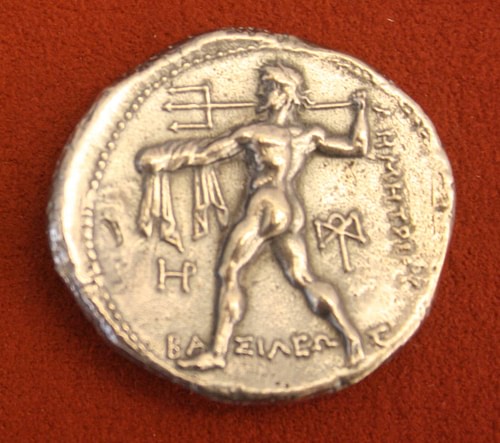
Poseidon
The god of the sea and bringer of storms and earthquakes, he often meddled in the plans of his brother Zeus. Son of Kronos and Rhea, he had many children, including Theseus, was responsible for such monsters as the Minotaur, and had a temple at Sounion dedicated to him.
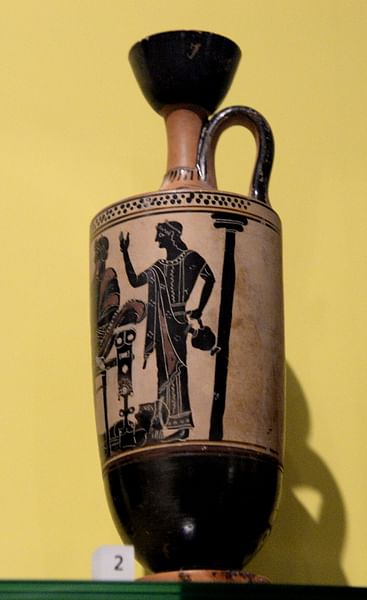
Priam
The king of Troy who was the son of Laomedon and father of Hector and Paris (along with 48 other sons and several daughters, including Cassandra). He persuaded Achilles to return Hector's body for proper burial with a moving speech in Homer's version of the Trojan War. The pious king was killed by Neoptolemus when his city was finally sacked.
Prometheus
The trickster Titan who stole fire from the workshop of Hephaistos and gave it to mankind. Zeus punished him for his interference by having an eagle eat his liver every day after he was taken to the far away east where he was chained to a rock. After many years of this terrible fate, Prometheus was finally relieved by a passing Hercules who shot the eagle with an arrow.
Rhea
The Titan who was both sister and wife of Kronos, with whom she bore the Olympian gods. She protected Zeus by giving her husband a rock wrapped in cloth to swallow as a substitute after he had a mind to eat all his offspring.
Satyr (aka Silens)
The lustful and wine-loving wild men of nature who had some animal features and followed Dionysos. Intelligent yet mischievous, the most famous of their number was Silenus, wise tutor of Dionysos.
Scylla
The monster which lived in a cave and preyed on passing sailors and sea-life going through the straits between Sicily and the Italian mainland. She had twelve feet, six heads, three rows of teeth and the bark of a dog. She is the daughter of Hecate.
Selene
The moon goddess. She was the daughter of Hyperion (or Helios) and Theia, who fell in love with Endymion. Unfortunately, Zeus took a disliking to the handsome youth and set him to sleep forever in a cave on Mt. Latmus to be visited every now and then by the goddess (the dark phase of the Moon).
Silenus
The satyr who was father of all the other satyrs. He was the wise tutor of Dionysos.
Siren
Half-bird half-woman creatures who lured sailors to their doom with beautiful singing. Odysseus famously avoided their call by tying himself to the mast of his ship when he passed their home near Scylla and Charybdis. With his escape they were fated to commit suicide, hence their frequent portrayal in art diving into the sea.
Sisyphus
The king of Corinth who cheated death twice by escaping Hades, the second time by arranging for his wife to forget the necessary funeral offerings to the gods. He lived to a ripe old age, but Zeus punished him for his impertinence by having him forever roll a stone up a hill when he reached the underworld for the third and last time.
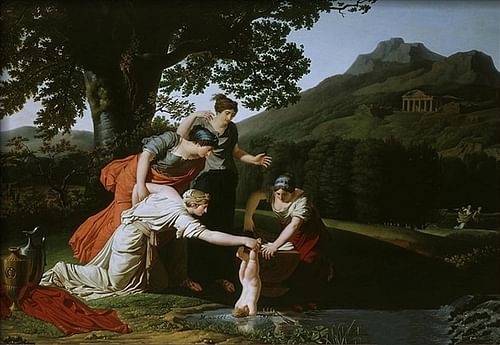
Styx
The eldest daughter of Oceanus and the personification of a river in Arcadia. Thetis, in one version of the myth, dipped Achilles into Styx's waters to make her son immortal. Later, she became the river that runs through Tartarus in the deepest part of the Underworld.
Talos (aka Kalos)
The bronze automaton made by Hephaistos to protect Europa, who then switched guard duties to Crete. He saw off trespassers by throwing large stones or heating himself red-hot and then embracing his victims. In some traditions he is killed by his jealous uncle Daedalus, in others, he is killed by Medea who released his magic life-source liquid, stored in his foot.
Tantalus
The rich king of Sipylus who was granted the honour of dining with the gods but somehow disgraced himself, either by stealing the gods' ambrosia or tricking them into eating his son Pelops whom he had previously boiled. Zeus punished him for his wickedness in one of those delicious tortures he often dished out. Down in Hades, Tantalus had to stand in a pool of water which drained every time he tried to take a drink from it, and above him dangled fruit which withdrew from his reach each time he tried to grab one (hence the verb 'tantalise').
Tartarus
The son of Gaia and Aether (Sky), he was the father of Typhon. It is also the name of the deepest level of Hades, where particularly wicked people like Sisyphus and Tantalus were punished, and where the unruly Titans are imprisoned.
Terpsichore
The Muse of dance.
Tethys
The Titan daughter of Gaia and Uranus who represented rivers along with her brother and consort Oceanus. She was the mother of the Oceanids (sea nymphs).
Thalia
The Muse of comedy theatre, hence usually depicted holding a comic theatre mask.
Themis
The primordial goddess, daughter of Gaia and Uranus, who was associated with prophecies, laws, and justice. Hesiod makes her the second wife of Zeus with whom she bore the Hours and Fates.
Theseus
The hero king of Athens who battled Amazons, centaurs, various villains, and most impressive of all, the Minotaur that dwelt in King Minos' labyrinth on Crete. He slew the dreadful creature and escaped the maze by using a ball of twine given to him by Ariadne. Tragically, on the return home, the hero forgot to change his sail from black to white and so his father Aegeus thought him dead and threw himself into the sea, thereafter known as the Aegean in his honour.
Thetis
The sea nymph who was the daughter of Nereus, wife of Peleus, and mother of Achilles. She transformed herself into many forms while her husband-to-be courted her but their eventual wedding was attended by the gods. She famously dipped her son into the River Styx (or held him over a sacred flame) to make him invincible with only his heel where she held him being left mortal.
Titans
The 12 terrible and mighty Titans preceded the Olympian gods with whom they battled for control of the universe and lost. Zeus then imprisoned them in Tartarus, the deepest part of Hades. Amongst their number were Kronos, Hyperion, Oceanus, and Rhea.
Triton
The fish-tailed monster who was the son of Poseidon and Amphitrite. He fought with Hercules but also helped Theseus. In Greek art, he sometimes blows a conch shell and his offspring carry the same name.
Typhon
Born from Gaia and Tartarus, he is the monster with 100 fire-blowing snake heads which make all the sounds of the animal kingdom. Zeus struck him down with his thunderbolt and imprisoned him in Tartarus deep in Hades, but he still causes trouble such as the occasional typhoon.
Urania
The Muse of astronomy and so often depicting holding a sphere.
Uranus (aka Ouranos)
The sky god who was born from Gaia. The pair marry and together they produce many other gods. One of these, Kronos, castrates his father and takes over his role as master of the universe. The genitalia of Uranus, cast into the sea, produces the goddess Aphrodite.
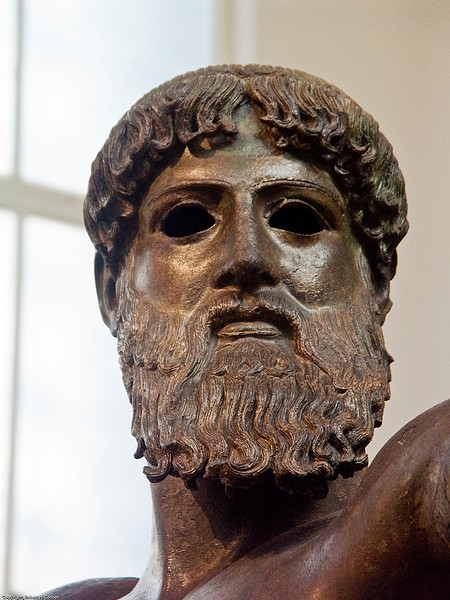
Zeus
The king of the Olympian gods and son of Kronos and Rhea, he was raised on Mt. Dikte, Crete by Gaia. He overthrew his father and, defeating both the Titans and Giants, he ruled supreme. Wedded to Hera but famously bedding many goddesses and mortals, he had numerous offspring, including Athena, Ares, Apollo, Hercules, and Perseus. He had an oracle at Dodona, a statue at Olympia (one of the Seven Wonders of the ancient world) and had the Olympic games held every four years in his honour. He is recognised in art by his thunderbolt.

